In today’s fast-paced world, healthcare is increasingly moving towards digital solutions, and apps like HealthTap are leading the charge. With millions of users seeking on-demand access to healthcare professionals, telehealth apps have become an essential tool for providing convenient and effective medical services. HealthTap, in particular, has revolutionized the way people interact with healthcare providers, offering virtual doctor consultations, personalized health advice, and prescription services—all from the comfort of home.
But creating an app like HealthTap doesn’t have to be expensive or time-consuming. Soluciones Miracuves offers a unique opportunity to build a fully functional health app in just 10 days, at 10% of the global cost. This guide will walk you through the process of developing a HealthTap-like app, from the technical requirements to monetization strategies, while saving you both time and money.
What is HealthTap and What Does It Do?
HealthTap is a leading telehealth platform that connects patients with certified doctors for virtual consultations. It offers a wide range of healthcare services, including live video calls, text-based chats, and AI-driven health insights. Patients can ask medical questions, receive personalized advice, and even get prescriptions—all without leaving their homes. This convenience has made HealthTap a trusted name in telemedicine, especially for those seeking immediate medical attention or ongoing healthcare management.
One of the key features of HealthTap is its focus on accessibility. The app allows users to access thousands of doctors across various specialties, ensuring that no matter the health concern, expert advice is always just a few clicks away. HealthTap also integrates with health records, making it easier for patients and doctors to maintain a comprehensive view of their health history. Additionally, its secure platform ensures that all interactions are HIPAA-compliant, protecting patient privacy at all times.
For businesses looking to replicate HealthTap’s success, it’s important to understand these core functionalities. A successful telehealth app should prioritize user-friendly design, reliable video conferencing, secure data handling, and comprehensive healthcare services. By offering a seamless virtual healthcare experience, businesses can tap into the growing demand for telemedicine and build a loyal user base.
| Característica | HealthTap | Teladoc | Médico a pedido | Amwell |
|---|---|---|---|---|
| Live Video Consultations | Sí | Sí | Sí | Sí |
| AI-Driven Health Insights | Sí | No | No | No |
| Prescription Services | Sí | Sí | Sí | Sí |
| Text-Based Chats | Sí | Sí | No | No |
| Specialist Access | Yes (Wide Range) | Yes (Limited) | Yes (Moderate Range) | Yes (Moderate Range) |
| HIPAA Compliance | Sí | Sí | Sí | Sí |
| Health Records Integration | Sí | Sí | Sí | Sí |
| Integración de seguros | Sí | Sí | Sí | Sí |
Why Build This App?
The rise of telehealth apps has transformed how people access healthcare. HealthTap is a prime example of how convenient and efficient digital healthcare solutions can be. With the increasing demand for telemedicine services—especially in the wake of the COVID-19 pandemic—now is the perfect time to build an app like HealthTap. This app can connect users to healthcare professionals instantly, regardless of geographical location, and help manage routine and emergency medical needs.
The healthcare industry is moving rapidly towards digital transformation, and consumers are looking for apps that provide quick and reliable medical services. A telehealth app can serve as a vital tool for both patients seeking accessible healthcare and healthcare providers looking to expand their services digitally. The global telehealth market is expected to reach $559.52 billion by 2027, proving that there’s substantial growth and revenue potential in this field.
What makes building an app like HealthTap even more appealing is the opportunity to do so in a cost-effective way. Soluciones Miracuves offers the chance to develop such an app at just 10% of the global cost and in 10 days, making it an ideal solution for businesses that want to enter the market quickly without overspending on development. By leveraging ready-made solutions, you can launch a fully functional telehealth app in a fraction of the time and cost it would typically take.
| Etapa de desarrollo | Global Cost Estimate | Miracuves Solutions Cost Estimate |
|---|---|---|
| Diseño y creación de prototipos | $1,000 – $2,000 | $100 – $200 |
| Desarrollo de frontend | $2,000 – $3,500 | $200 – $350 |
| Desarrollo backend | $2,500 – $4,000 | $250 – $400 |
| Testing & Debugging | $500 – $1,000 | $50 – $100 |
| Lanzamiento y despliegue | $500 – $1,000 | $50 – $100 |
| Total Cost | $6,500 – $11,500 | $650 – $1,150 |
How to Differentiate Your App from Others
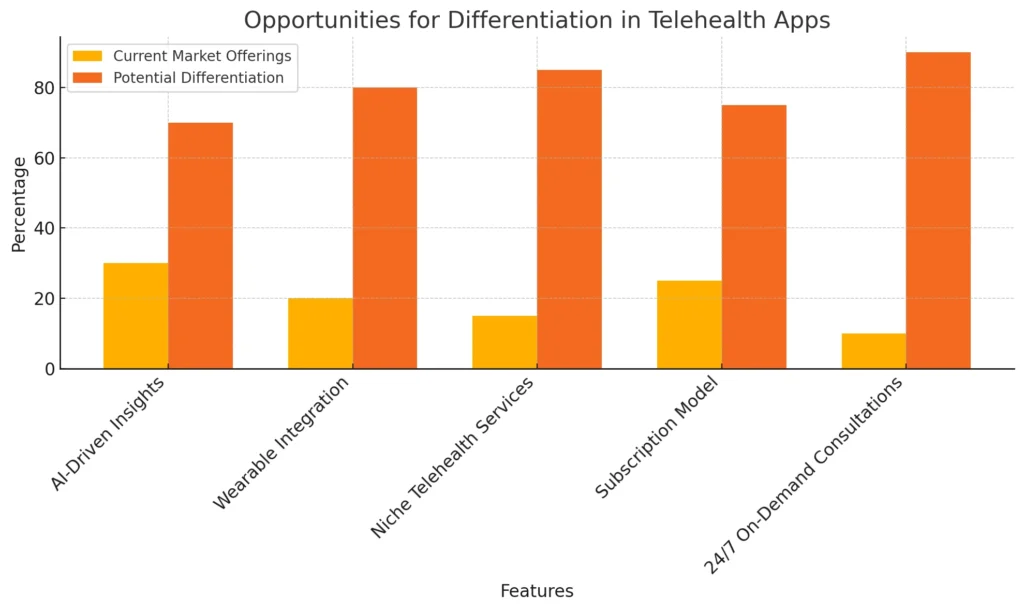
In the rapidly growing telehealth market, standing out from competitors like HealthTap, Teladoc, and Amwell is crucial for success. While these platforms offer core services like virtual consultations and prescription services, creating unique features for your app can help you carve out a distinct space in the market. The key to differentiation lies in offering added value to users through innovation and personalization.
One way to differentiate is by integrating AI-driven health insights that provide users with personalized health advice based on their medical history and real-time data. For example, your app could analyze user inputs and suggest lifestyle changes, preventive measures, or even recommend specialists based on AI predictions. Another potential differentiator is incorporating wearable device integration. By syncing with health trackers like Fitbits or Apple Watches, your app can give users real-time insights into their fitness, sleep, and overall health metrics.
Telehealth services for specific demographics—such as mental health support or chronic disease management—can also make your app stand out. Many existing platforms focus on general health consultations, but by specializing in a niche, you can attract a loyal user base looking for targeted care. Finally, offering a modelo de suscripción with premium features like 24/7 on-demand consultations or priority doctor access could enhance user retention and set your app apart.
Market Size, Growth, Revenue, and Business Model
The telehealth market is on a meteoric rise, driven by an increasing demand for remote healthcare solutions and the convenience they offer. In 2023, the global telehealth market was valued at approximately $95 billion, and it’s expected to grow to $559.52 billion by 2027. This exponential growth is fueled by advancements in technology, increased access to high-speed internet, and a shift in patient preferences toward virtual consultations.
Telehealth apps, like HealthTap, capitalize on a subscription-based business model o un pay-per-consultation model, generating steady revenue streams. Subscription models, in particular, are becoming increasingly popular as they offer users access to unlimited consultations for a monthly or yearly fee. This recurring revenue model creates financial stability for businesses while ensuring patients have access to ongoing care.
Additionally, revenue is generated through partnerships with healthcare providers, offering telehealth services as part of insurance packages, or via premium features, such as priority doctor access, 24/7 consultations, and specialized services. With the integration of advanced features like AI-driven health insights y wearable integration, businesses can offer additional services at premium prices, further boosting their revenue potential.
As the industry continues to grow, the opportunity to launch a telehealth app and capture a share of this booming market has never been more lucrative.
| Región | Market Size in 2023 (USD Billion) | Projected Market Size in 2027 (USD Billion) | Tasa de crecimiento (%) |
|---|---|---|---|
| América del norte | $40.2 | $210.5 | 25% |
| Europa | $25.1 | $140.7 | 28% |
| Asia-Pacífico | $18.3 | $125.9 | 35% |
| América Latina | $6.4 | $38.6 | 32% |
| Middle East & Africa | $5.0 | $44.8 | 41% |
Features of HealthTap
To replicate the success of an app like HealthTap, it’s crucial to understand its core features. HealthTap is designed to offer a seamless healthcare experience, focusing on ease of use and accessibility. At its core, the app connects users with licensed doctors for virtual consultations through video calls, voice calls, or text messaging. This instant access to healthcare professionals is what makes telehealth apps indispensable, especially for patients who prefer the convenience of remote consultations.
Another standout feature is AI-driven health insights, which allows users to receive personalized health recommendations based on their symptoms, medical history, and even questions asked in the app. This AI component not only enhances user engagement but also adds a layer of proactive healthcare management by providing users with suggested treatments or preventive measures.
HealthTap also includes electronic health record (EHR) integration, ensuring that both patients and doctors have access to comprehensive medical histories during consultations. This feature allows for a more informed and accurate diagnosis, improving the overall quality of care.
Other key features include insurance integration for billing and claims, prescription services to facilitate the delivery of medications, and a patient portal where users can view their health records, prescriptions, and doctor recommendations in one place.
By incorporating these features, your app can offer a holistic telehealth solution that meets the growing demand for digital healthcare services.
Technical Requirements
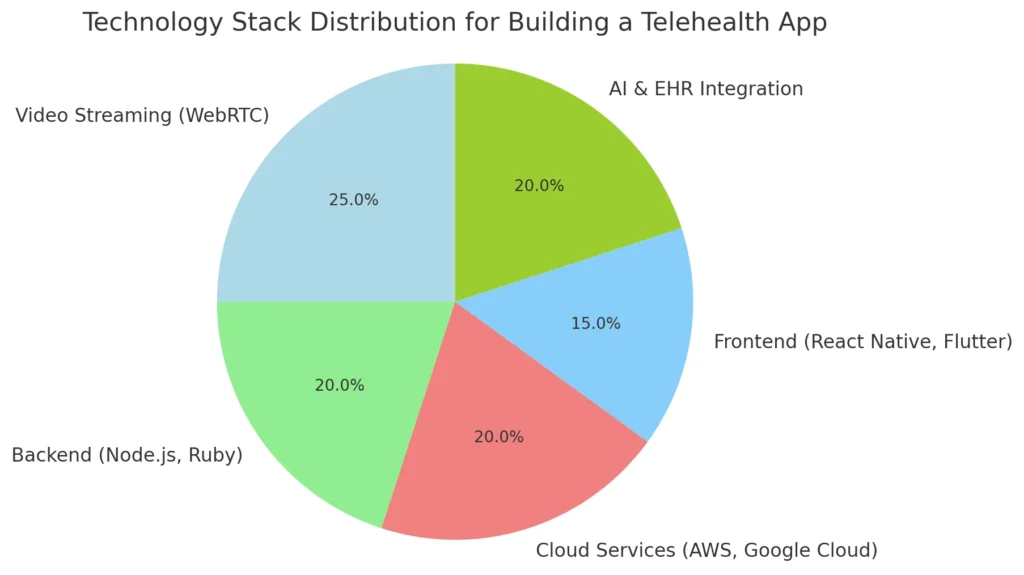
Building a telehealth app like HealthTap requires a robust technology stack to ensure smooth performance, scalability, and security. The foundation of the app lies in its ability to provide real-time video consultations, which demands the use of powerful video streaming protocols such as WebRTC. This technology ensures high-quality video calls with minimal latency, providing users with a seamless experience even in areas with slower internet connections.
For the backend, frameworks like Node.js o Ruby on Rails are popular choices due to their flexibility and ability to handle a high number of concurrent users. These frameworks support the comunicación en tiempo real features that are essential for telehealth apps. Additionally, the backend should integrate with secure cloud services como AWS o Nube de Google to store sensitive medical data safely. Ensuring that the app is HIPAA-compliant is crucial, as protecting user privacy and healthcare data is non-negotiable in this industry.
On the frontend, Reaccionar nativo o Aleteo can be used to create a smooth, cross-platform app that works seamlessly on both Android and iOS devices. These frameworks offer fast development cycles and ensure that the user interface remains responsive and intuitive.
Other technical considerations include integrating AI algorithms for personalized health advice and EHR systems for health record management. Both of these require reliable APIs that can interact with various healthcare databases and platforms to provide accurate and timely information to users.
The app’s real-time video consultations require robust video streaming protocols such as WebRTC, which ensures high-quality video calls with minimal latency.
Design and User Interface (UI/UX)
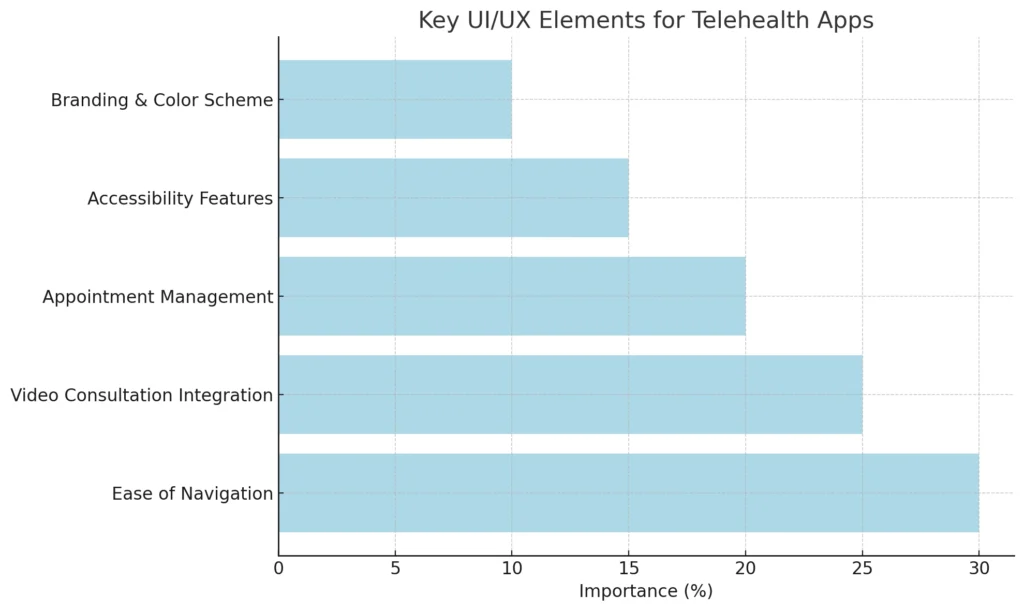
When building a telehealth app like HealthTap, the Experiencia de usuario (UX) is just as important as the technical functionality. The app’s design needs to be intuitive and user-friendly, catering to a diverse audience, including those who may not be tech-savvy. A clear, clean interface that allows users to easily navigate through features such as booking a consultation, viewing medical records, or chatting with a doctor is crucial for high user satisfaction.
A critical aspect of telehealth app design is ensuring that the video consultation feature is seamlessly integrated into the user interface. The design should make it easy for users to join calls with doctors, manage appointment schedules, and access relevant information during consultations. Moreover, integrating notifications and reminders for upcoming appointments enhances the user experience and ensures they don’t miss critical consultations.
Accessibility should also be a key consideration. This includes designing for different screen sizes and ensuring that the app is fully responsive on both iOS and Android devices. In addition, for users with visual or hearing impairments, the app should offer features like text-to-speech functionality or closed captioning during video calls.
Finally, a strong branding and color scheme aligned with the healthcare sector is essential. Colors like green, blue, or white are often used to evoke feelings of trust, calm, and professionalism. Incorporating these design elements will help create an environment where users feel comfortable seeking healthcare advice.
Development Process
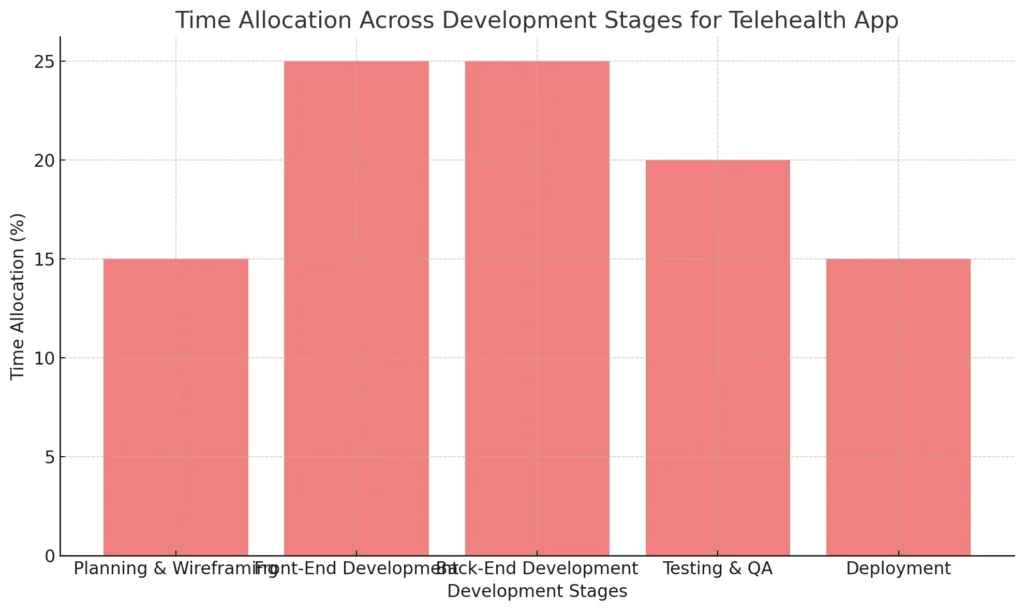
Building an app like HealthTap requires a well-structured development process that ensures efficiency, scalability, and quality. Typically, this process can take months, but with ready-made solutions, you can significantly reduce the timeline to as little as 10 days.
The first step in the development process is planning and wireframing. During this stage, the app’s layout and user flow are mapped out to ensure the user interface is intuitive and easy to navigate. Wireframes serve as blueprints, outlining where each feature, button, and screen will be placed.
Once the wireframes are approved, the next stage is front-end and back-end development. The front-end focuses on creating the app’s design and functionality, ensuring a seamless user experience across devices. This involves using frameworks like Reaccionar nativo o Aleteo for cross-platform compatibility. Simultaneously, back-end development ensures the app’s server-side infrastructure is robust enough to handle real-time video consultations, messaging, and secure data storage.
Following development, the app enters the testing phase, where quality assurance teams rigorously test for bugs, security vulnerabilities, and overall performance. This step is crucial for identifying issues before the app goes live. Testing includes functionality testing, usability testing, and security testing, especially important for HIPAA compliance in telehealth apps.
Finally, after testing, the app is ready for deployment. At this point, the app is launched on platforms like Google Play Store and Apple App Store, optimized for searchability through Optimización de la App Store (ASO).
Cost Estimation and Timeframe
| Etapa de desarrollo | Global Cost Estimate | Miracuves Solutions Cost Estimate |
|---|---|---|
| Diseño y creación de prototipos | $5,000 – $10,000 | $500 – $1,000 |
| Desarrollo de frontend | $15,000 – $30,000 | $1,500 – $3,000 |
| Desarrollo backend | $20,000 – $40,000 | $2,000 – $4,000 |
| Pruebas y control de calidad | $5,000 – $10,000 | $500 – $1,000 |
| Lanzamiento y despliegue | $3,000 – $5,000 | $300 – $500 |
| Total Cost | $50,000 – $95,000 | $5,000 – $9,500 |
When it comes to developing a telehealth app like HealthTap, cost and time are two of the most critical factors. Globally, building such an app from scratch can cost anywhere between $50,000 a $200,000, depending on the features, complexity, and region. This includes expenses for design, development, testing, deployment, and maintenance. Additionally, the development process can take several months, sometimes up to 6 months to a year for a fully functional telehealth app.
However, with Soluciones Miracuves, these barriers of high cost and long timelines can be significantly reduced. By utilizing ready-made app solutions, the cost can drop to as low as 10% of the global price—approximately $600 instead of the traditional $6,000 for similar features. Not only is the cost lower, but the timeframe is also drastically reduced. Instead of waiting months for development, you can have a fully functional telehealth app up and running in just 10 days.
This reduced cost and time come without compromising quality. The ready-made solutions provided by Soluciones Miracuves ensure that the app is scalable, secure, and fully customizable to meet specific business needs. For entrepreneurs or businesses looking to enter the booming telehealth market quickly, this is an unparalleled advantage.
Estrategias de monetización
Once your telehealth app is up and running, the next crucial step is figuring out how to generate revenue. There are multiple monetization strategies that can help turn your app into a sustainable business while offering value to users.
One of the most popular models in telehealth is the modelo basado en suscripción, where users pay a monthly or yearly fee for unlimited access to virtual consultations, health advice, and premium features. This model works particularly well because it provides a steady stream of recurring revenue and offers users the convenience of uninterrupted healthcare access.
Another effective strategy is pay-per-consultation, where users pay for each doctor visit or consultation individually. This model is ideal for users who may not need frequent consultations but value the flexibility of accessing healthcare professionals as needed. Additionally, the freemium model can be employed, where the basic version of the app is free, but users can upgrade to premium features such as 24/7 on-demand consultations, access to specialists, or AI-powered health recommendations.
You can also explore publicidad y asociaciones with healthcare providers, insurance companies, or pharmaceutical companies. Offering in-app advertisements for relevant healthcare products and services can generate additional revenue. Partnerships with insurance providers can further streamline the user experience by offering insurance-backed consultations, which users may prefer for convenience and cost-saving.
By adopting a combination of these monetization strategies, you can ensure that your app not only helps users access critical healthcare services but also generates consistent revenue for your business.
Launching and Marketing the App
After developing a fully functional telehealth app, the next step is to launch and market it effectively. A successful launch starts with optimizing the app for the App Store (for iOS) and Tienda Google Play (for Android). This involves making sure the app is easily searchable through Optimización de la App Store (ASO). ASO focuses on using relevant keywords in the app title, description, and tags, ensuring that potential users can find your app when searching for telehealth services.
Construyendo una pre-launch marketing strategy is also critical. Start by creating a buzz on social media platforms to attract early users. You can generate interest through teasers, demo videos, or even offering a beta version for users to try. Consider working with healthcare influencers or professionals who can review and recommend the app to their followers, giving your app a sense of credibility.
Once the app is live, running paid campaigns on platforms like Anuncios de Google o Facebook Ads can help target the right audience—people searching for online healthcare solutions. You can also leverage email marketing, sending targeted emails to prospective users or those already interested in healthcare apps. Offering incentives like discounts on the first consultation or free trials for premium features can help boost initial downloads.
Engaging in partnerships with healthcare organizations o insurance providers can also provide a wider reach, helping your app tap into established user bases. By offering co-branded services or including your app in healthcare insurance plans, you can secure long-term users and drive growth.
Legal and Regulatory Considerations
When building a telehealth app, one of the most critical aspects to consider is ensuring compliance with legal and regulatory standards. In healthcare, data privacy and patient confidentiality are non-negotiable, especially when handling sensitive information like medical records and consultations. To protect both users and your business, the app must comply with various regulations, depending on the region in which it operates.
In the United States, for example, your telehealth app must adhere to HIPAA (Health Insurance Portability and Accountability Act). HIPAA ensures that all healthcare-related data is securely stored and transmitted, protecting it from unauthorized access. This means that every feature of your app, from video consultations to data storage, must follow encryption protocols and secure data handling practices.
In the United States, your telehealth app must adhere to HIPAA, ensuring that healthcare-related data is securely stored and transmitted, protecting it from unauthorized access.
For businesses operating in Europe, compliance with RGPD (General Data Protection Regulation) is essential. GDPR governs how businesses collect, store, and use personal data, giving users more control over their information. Ensuring that users can manage their consent and have access to their data is crucial for GDPR compliance.
Additionally, many regions have telemedicine-specific regulations that cover the licensing and qualifications of healthcare providers. Your app should only allow consultations from doctors who are properly licensed to practice in the region where the patient is located. This ensures that both users and healthcare providers are protected from legal liabilities.
Finally, the app must comply with app store regulations set by platforms like Google Play and the Apple App Store. Ensuring your app meets the guidelines for health apps will prevent delays in approval and ensure a smooth launch.
Future Growth of the App
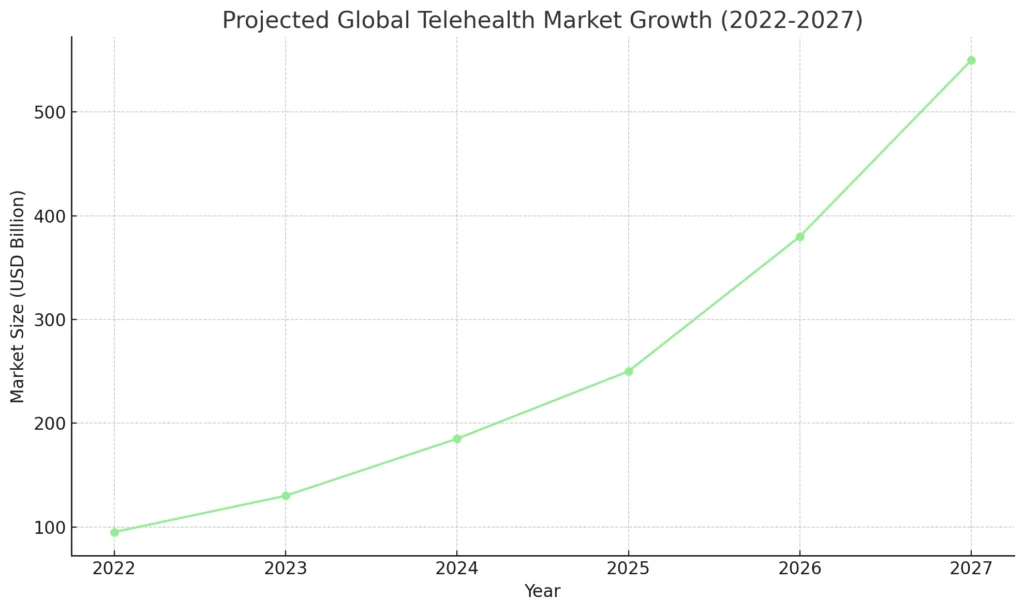
The telehealth industry is projected to experience substantial growth in the coming years, creating immense opportunities for app developers. With an increasing demand for convenient and accessible healthcare solutions, telehealth apps like HealthTap are well-positioned to capitalize on the market’s expansion. By 2027, the global telehealth market is expected to reach over $550 billion, driven by advancements in technology, increased access to high-speed internet, and changing patient preferences.
One of the key factors contributing to this growth is the rise of wearable technology y AI-powered health solutions. By integrating with wearables such as smartwatches and fitness trackers, your telehealth app can provide users with real-time health monitoring and data-driven insights. This not only adds value to the user experience but also opens up new revenue streams through premium services and personalized healthcare recommendations.
Another avenue for future growth is the expansion into mental health services. As mental health awareness increases, there is growing demand for telehealth apps that provide counseling, therapy, and psychiatric consultations. Offering specialized services in this area can help your app stand out from the competition and attract a niche audience.
Additionally, as regulations around telemedicine continue to evolve, there will be opportunities to expand your app’s services to new regions or markets that were previously inaccessible. Ensuring that your app is scalable and adaptable to different healthcare systems will enable you to tap into these emerging opportunities.
By focusing on innovation, user engagement, and adapting to future trends, your telehealth app can remain relevant and continue to grow alongside the industry.
Why Do You Trust Miracuves Solutions for Your Next Project?
When it comes to building a telehealth app like HealthTap, trust is a critical factor. Soluciones Miracuves offers a proven, cost-effective way to bring your app to life while maintaining high standards of quality and performance. But why should you trust Miracuves Solutions for your next project?
First, expertise and experience are at the heart of what Miracuves Solutions offers. With a track record of delivering ready-made app solutions across multiple industries, you can be confident that your project is in capable hands. Whether you’re looking to build a telehealth app or a similar platform, the team has the necessary technical knowledge to deliver results.
Second, the company’s focus on cost efficiency is unparalleled. While global development costs can run into the tens of thousands, Soluciones Miracuves can develop a HealthTap-like app at 10% of the global cost, providing significant savings without compromising on functionality.
Third, speed is another reason to trust Miracuves. Instead of waiting months to develop your app, Miracuves Solutions offers a turnaround time of just 10 days, allowing you to enter the market faster and gain an edge over your competition.
Finally, the customization and scalability of their ready-made solutions ensure that your app can grow with your business. You can start with a minimum viable product (MVP) and gradually expand features as your user base grows, all without having to rebuild the app from scratch.
With a strong commitment to quality, efficiency, and customization, Soluciones Miracuves is the trusted partner for your next telehealth app project.
Conclusión
In today’s rapidly evolving healthcare landscape, building a telehealth app like HealthTap is not only a smart business move but also a way to provide essential healthcare services to millions of users. With the growing demand for remote medical consultations and personalized healthcare, launching a telehealth app can help you tap into a booming market while making healthcare more accessible.
Por Asociándose con Miracuves Solutions, you can achieve this goal quickly and cost-effectively. With their ready-made solutions, you can reduce development costs by 90% and get your app to market in just 10 days. The combination of expertise, speed, and affordability makes Miracuves Solutions the ideal partner for turning your telehealth app idea into a reality.
Whether you’re looking to create a full-scale app or start with an MVP, Miracuves Solutions ensures that your app is scalable, secure, and ready to meet the needs of today’s healthcare users. Now is the perfect time to bring your vision to life and lead the future of healthcare innovation.
Preguntas frecuentes
How much does it cost to build an app like HealthTap with Miracuves Solutions?
Con Soluciones Miracuves, you can develop a fully functional telehealth app at 10% of the global cost, which means you could save thousands compared to traditional development methods.
How long does it take to develop a HealthTap-like app?
Using Miracuves Solutions’ ready-made app solutions, the development process can be completed in just 10 days, significantly faster than the typical months-long timeline.
What technology stack is used in Miracuves Solutions’ ready-made apps?
Miracuves Solutions uses modern and robust technologies like WebRTC for video calls, Node.js for the backend, and Reaccionar nativo o Aleteo para desarrollo multiplataforma.
Can I customize my telehealth app?
Yes, Miracuves Solutions offers full customization options, allowing you to tailor your app to your specific needs, whether it’s adding new features, changing the design, or scaling for future growth.
How do I ensure my app complies with healthcare regulations?
Miracuves Solutions ensures that your app adheres to regulations like HIPAA in the U.S. and RGPD in Europe, providing secure and compliant handling of patient data.





























































